Nestled in the heart of the Veneto Region, arguably one of the most striking destinations on your Northern Italy itinerary, Padua is often regarded as Venice’s cultured neighbor.
A hub for art, history, architecture, and intellectual legacy, Padua is home to one of the oldest universities in Europe, where Galileo Galilei taught mathematics for nearly 20 years at the turn of the 17th century.
The multifaceted city offers a plethora of activities to enjoy, from its iconic museums, libraries, and centuries-old college to incredible architecture, vibrant markets, and the oldest botanical garden in the world.
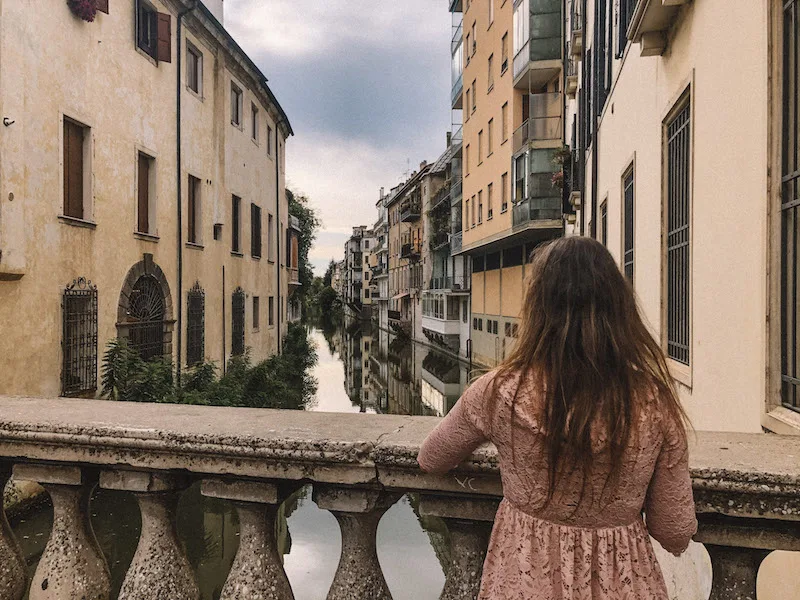
It’s also renowned for its religious heritage, and seamlessly blends modernity with tradition, resulting in a beautiful city that’s well worth the visit. Besides, Padua is one of the oldest cities in Northern Italy, a major attraction for history buffs!
The city is small enough to be a perfect day trip destination from nearby locations, but you can also stay in Padua and enjoy a leisurely few days basking in its culture and roaming its cobblestone streets.
I’ve previously published a guide to Padua, Italy. In this post, you’ll discover the best things to do in Padua in more detail. Find anything from intellectual visits to wine tastings and blissful river cruises. Read on!
Why can you trust these recommendations? While I’m not a local, my entire family is! With cousins, uncles, and aunts who live in Padua, the recommendations and insights you’ll find here are straight from those who know the city best. This guide offers you the chance to experience Padua not as a tourist, but with the knowledge and secrets of its true residents.
Table of Contents
Walk around the Historical Center
Padua’s historic center dates all the way back to Roman times, when it was a prosperous settlement by the name of Patavium. The area continued to flourish under Renaissance influence, and it now showcases the city’s rich cultural heritage through its Medieval and Renaissance buildings.
The historic city center of Padua has a lot to offer, as it’s home to some major Padua attractions and boasts irresistible charm.
▶️ Things you can’t miss there include strolling along Via Umberto I, a mainly pedestrian street lined by boutiques and shops selling everything from souvenirs to clothing and accessories, tempting gelaterias, restaurants, and cafés.
You’ll also admire the architecture as you pass by historic buildings with interesting facades and intricate details – one of the best attributes of the lively street.
▶️ Via Roma is another significant street in the historical district worth exploring. Found in the heart of the city center, it’s a fantastic starting point to explore Padua as it intersects many streets that will lead you to important landmarks and sights.
You’ll also find magnificent architectural gems, and bustling eateries where to stop for a coffee and very interesting people-watching.
▶️ The mighty University of Padua, which happens to be the second oldest university in Italy, dating back to the 13th century, is also located here. Originally founded as a school of law, Padua University was esteemed as one of the most prestigious in the continent and was home to none other than Galileo Galilei for close to two decades.
▶️ After visiting the ancient building, make your way to Piazza Duomo, where the Padua Cathedral lies. Dedicated to the Assumption of the Virgin Mary, the first Cathedral was built in the 4th century, and it constitutes one of the key elements in the rich religious patrimony of the city.
▶️ There’s also the Diocesan Museum, which is housed in the former residence of the Bishops of Padua, and the awe-inspiring Baptistery of Padua.
➤ The Private City Walking Tour of Padua & Scrovegni’s Chapel Visit is a perfect introduction to Padua. You’ll wander around its major streets and squares with a local guide, learning about the culture and history of Padua. The tour includes a visit to the Scrovegni Chapel, as well as the Cathedral and Palazzo della Ragione. ➥ BOOK IT HERE
➤ This Live Padua as a Local is a half-day tour around Padua city center led by a native, which will allow you to see the most authentic side of the city. You’ll walk around the major landmarks while learning about Padua’s history and customs, and finish at the historic Caffè Pedrocchi for a coffee. ➥ BOOK IT HERE
Be Amazed by Prato della Valle Square
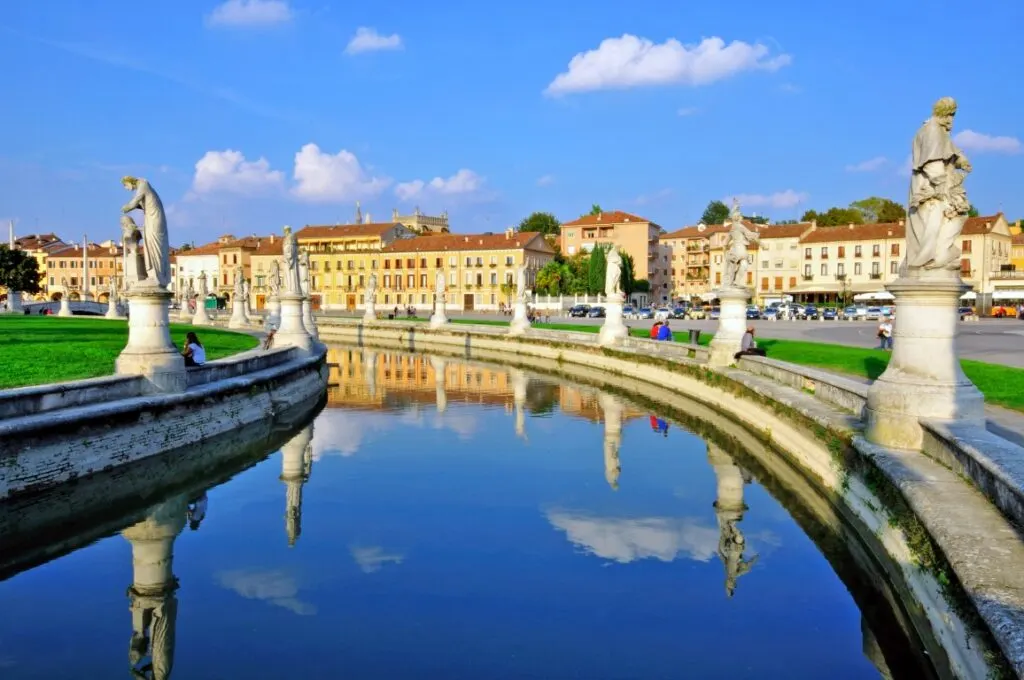
There’s no place in Padua like Prato della Valle, the largest square in Italy and one of the most gorgeous.
The 1 million-square-foot (90,000-square-meter) elliptical square features a magnificent green island in the center, encircled by a canal that is lined by statues on both sides and by various concentric rings of walkways.
Its greenery makes it feel more like a park, and it’s a beautiful place to go for a leisure stroll or spend a few hours in Padua relaxing under the trees.
Right in the heart of the square lies a fountain of drinkable water, and four tree-lined radial avenues connecting it to the outer edges, creating a striking layout.
This unique square is surrounded by historic buildings, and it’s one of the most beautiful attractions in Padua, so you can’t miss it!
Take a Cruise Along the Brenta River
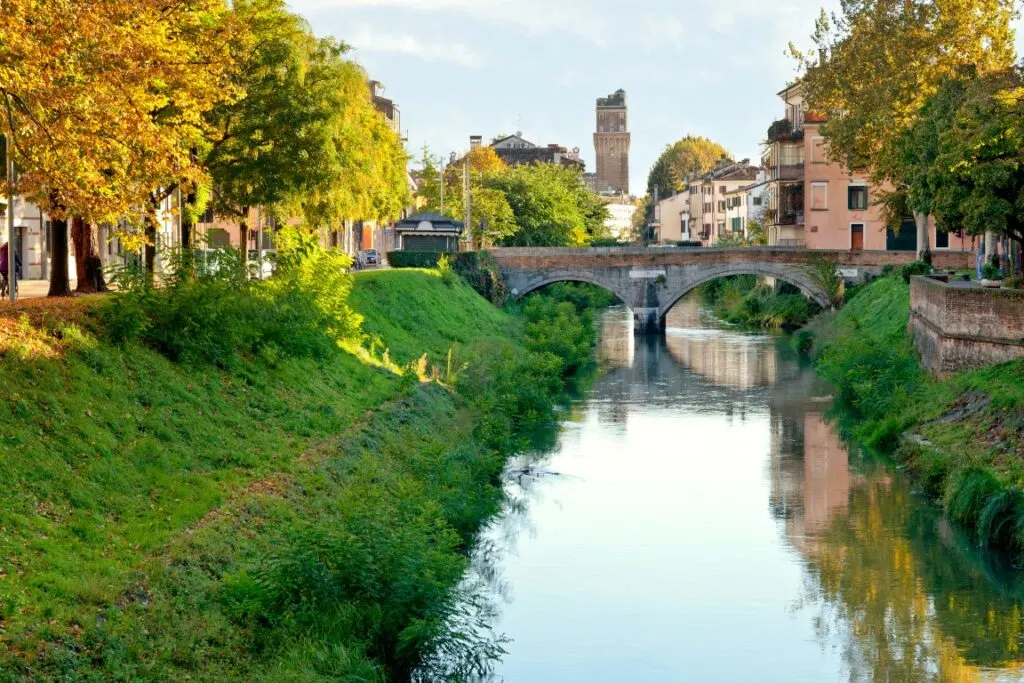
The Brenta River, which runs from Trentino to the Adriatic Sea, passes by the region of Padua and borders the city on the northeast.
Water being one of the most important elements of the region, most major cities in Veneto featured networks of canals, and ancient ones connect Padua with Venice, which were originally used for the transportation of goods and people.
You can retrace the steps of the locals by taking a cruise along the river down to Venice, gliding past the peaceful countryside and very lavish architecture.
Back in the day, Venetian aristocrats would build their summer residences on the shores of the river, so besides getting to discover the history and landscapes of the region you’ll enjoy a glimpse of the opulent villas that line the river.
You’ll most likely board a burchiello, a traditional Venetian boat, and set sail to admire the magnificent passing views as you sit and relax.
Keep your eyes peeled for the various towns you’ll glide past, and for Villa Pisani, one of the most renowned residences along the Brenta.
Unless you’re visiting Padua in one day, which wouldn’t give you enough time, going on a Brenta River cruise is definitely a highlight!
➤ The Full-Day Padua to Venice Burchiello Brenta Riviera Boat Cruise is an incredible 9-hour journey that starts and Padua and takes you sailing along the famous river. You’ll stop to visit four astounding villas, and have lunch at an iconic Oriago restaurant. The cruise, which includes a professional guide, finishes in Venice. ➥ BOOK IT HERE
I would suggest doing this activity on your last day in Padua and combining it with Venice, as it’s a one-way cruise that stops in the city of canals. It’d be advisable to book your accommodation there in advance as well!
Admire the Beautiful Scrovegni Chapel
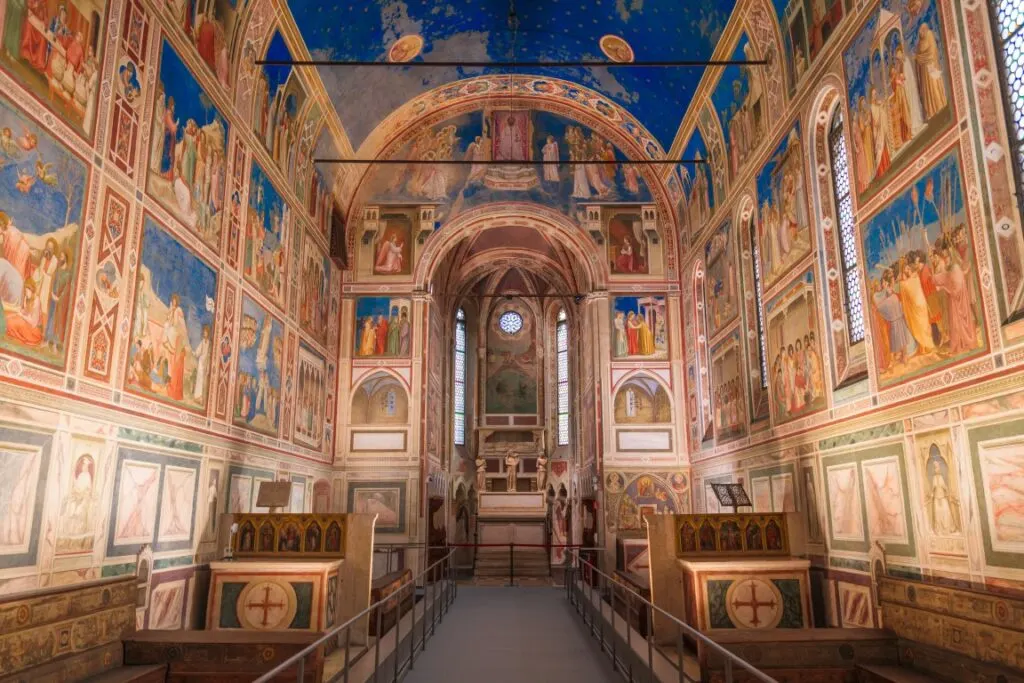
Scrovegni Chapel is possibly one of the most beautiful buildings in town. Also known as Capella degli Scrovegni, the rather small building is celebrated for the extraordinary frescoes it houses, painted by the Italian artist Giotto di Bondone.
It’s one of Italy’s prettiest chapels, and no visit to Padua would be complete without checking it out.
The visually striking frescoes that adorn the chapel’s interiors recount the life of Jesus and the Virgin Mary, portraying various biblical scenes in vibrant colors and unique use of composition and light.
Every inch of the Capella’s interior is covered, and the highlight is arguably the Last Judgement fresco which takes up an entire wall and is incredibly detailed.
The chapel is named after the Scrovegni family, commissioned by Enrico Scrovegni – along with the larger complex the chapel is part of – as a means of redeeming his usurer father’s sins.
To preserve the impressive artwork, both temperature and humidity within the chapel are closely monitored, and the number of daily visitors is limited, so make sure to book your tickets ahead of time.
Scrovegni Chapel Opening Hours: Daily from 9 AM to 7 PM.
Scrovegni Chapel Entrance Fee: 15€ + 1€ presale fee.
Have Coffee & Pastries at Caffè Pedrocchi
Caffè Pedrocchi is pretty much an institution in Padua, serving espresso since the 1700s. It’s the oldest café in the city, and has gained fame all over the country and abroad as well.
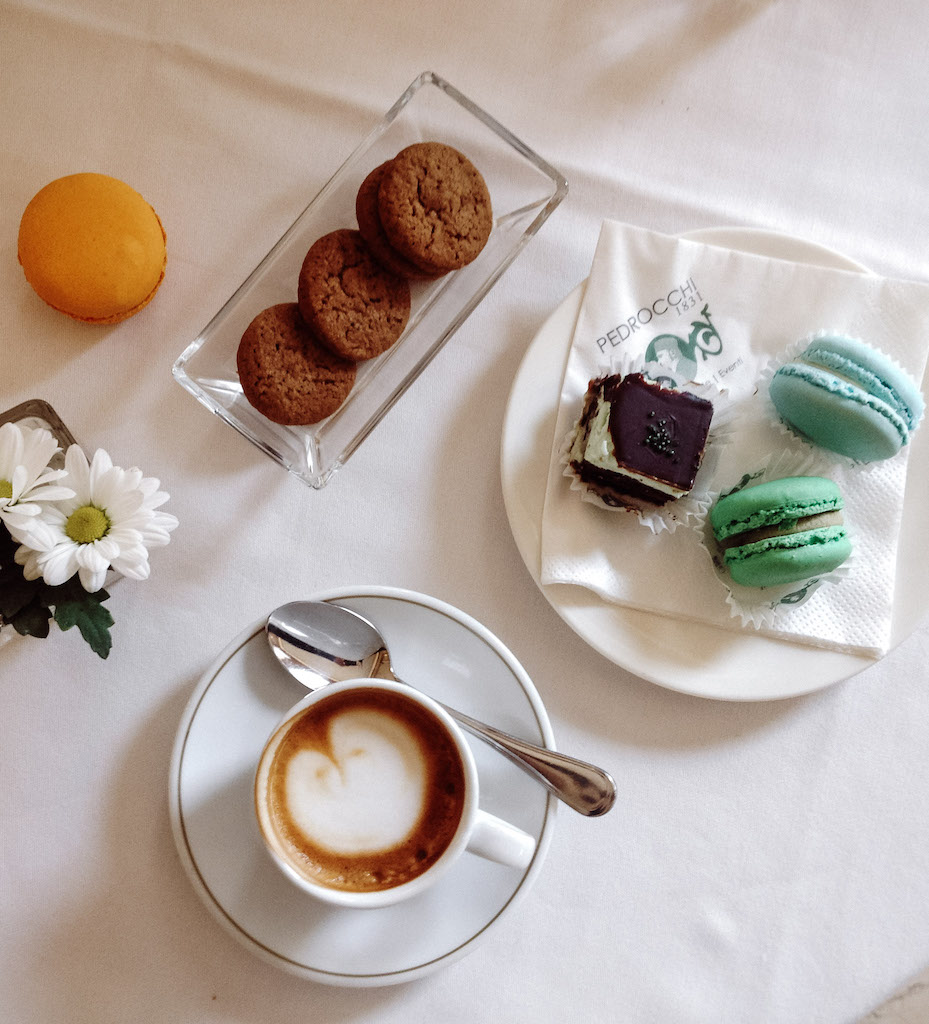
The exclusive venue serves the most celebrated coffee in Padua, and even has its own Pedrocchi coffee which is meant to be taken just as it’s served: no sugar or stirring allowed!
The café also has an in-house patisserie serving the most exquisite desserts, and a restaurant where you can try all the Venetian classics for lunch or dinner. It makes for a great stop in Padua to refuel
Housed in a historic building, the café areas are vast and divided into different rooms, each one as elegant as the previous one and categorized per color. The café is a popular spot for hosting events and organizes everything from weddings to business meetings and private parties.
On the day of your visit, order one of their specialty coffees, as it’s one of the best places in the city for a good cup of joe.
Check the Market at Piazza delle Erbe
In Italian, Erbe literally means herbs, and the word is used to name various piazzas around Italy which were known for the markets they held. Padua’s Piazza delle Erbe is no exception.
This historic square located right in the heart of the city is a bustling hub for both locals and tourists, and it’s been Padua’s focal point for centuries.
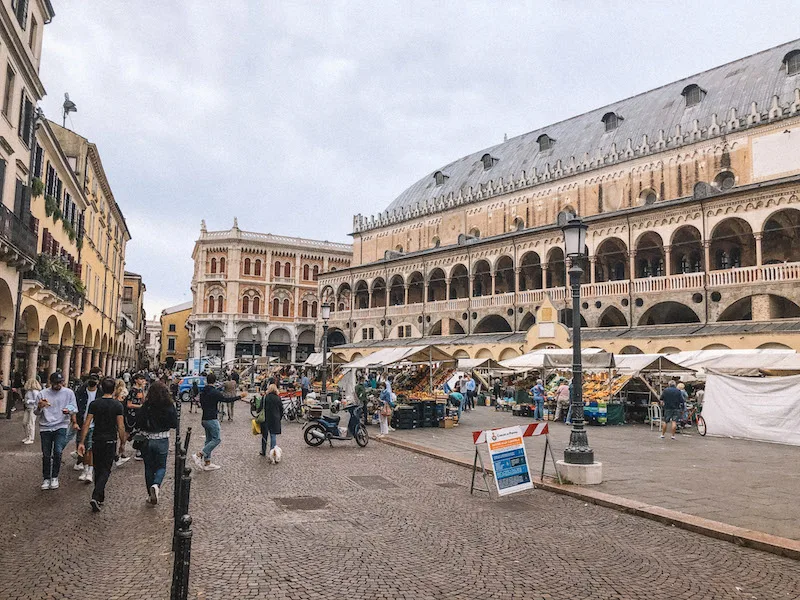
Ever since Medieval times, the square has been regarded as the city’s marketplace – hence its name – where sellers and buyers would gather every day to exchange goods. While the daily market is no longer a necessity for modern Padua dwellers, the tradition still lives.
Every Saturday, the piazza buzzes with activity as vendors show up with produce, souvenirs, flowers, and artisanal goods to sell.
The square is encircled by beautiful architecture and important buildings, including Palazzo Moroni and Palazzo delle Debite, and the cafés and bars located around it are part of the reason why, to this day, Piazza delle Erbe continues to be one of the main social hubs of the city.
Find the Astronomical Clock in Piazza dei Signori
Places to visit in Padua also include the popular Piazza dei Signori, an open area that, like most piazzas in the city, is surrounded by monumental buildings, reflecting the architectural beauty of the place.
Piazza dei Signori is a historic square dating all the way back to Roman times, and it’s named after the Signori (the rulers) who lived and worked there.
The indisputable gem of this square in Padua is Torre dell’Orologio, which houses the city’s spectacular Astronomical Clock. An engineering and artistic masterpiece from the 14th century, the clock had to be rebuilt in the 1420s after being destroyed by war and fires.
The clock features quadrants showing the hours, minutes, days, and months, and the inner band indicates the lunar phases and the astrological signs.
The magnificent clock tower has five floors, all of which are dedicated to the workings of the astronomical clock: the first three floors house its machinery, and the two upper ones were home to the clock master, who needed to look after the workings of the clock permanently.
Step Into the Palazzo della Ragione
Believed to be one of the oldest medieval halls in existence, Palazzo della Ragione is a striking building that separates Piazza delle Erbe from Piazza della Frutta.
The building is divided into two floors; the upper one used to house the Palace of Justice and the town hall, where commercial and civic meetings took place.
The ground floor, however, is where the medieval, covered market hall was located, and which bustled with activity on a daily basis.
The Palazzo dates back to the 13th century, and its significance to the city of Padua goes way beyond its being the oldest European market hall. Its architectural wonders include the spectacular wooden roof that’s considered one of the largest unsupported ceilings on the continent.
A visit to Palazzo della Ragione is an absolutely treat to the eyes, as the massive salone and beautiful market are incredibly aesthetic. The best part is that you’ll see the incredible frescoes that cover the great hall in its entirety, and which in 2021 were added to the UNESCO list of Padua’s 14th-century fresco cycles.
Palazzo della Ragione Opening Hours: Tuesday to Sunday from 9 AM to 6.30 PM.
Palazzo della Raggione Entrance Fee: 10€.
Don’t Miss the Botanical Garden of Padua (a UNESCO World Heritage Site!)
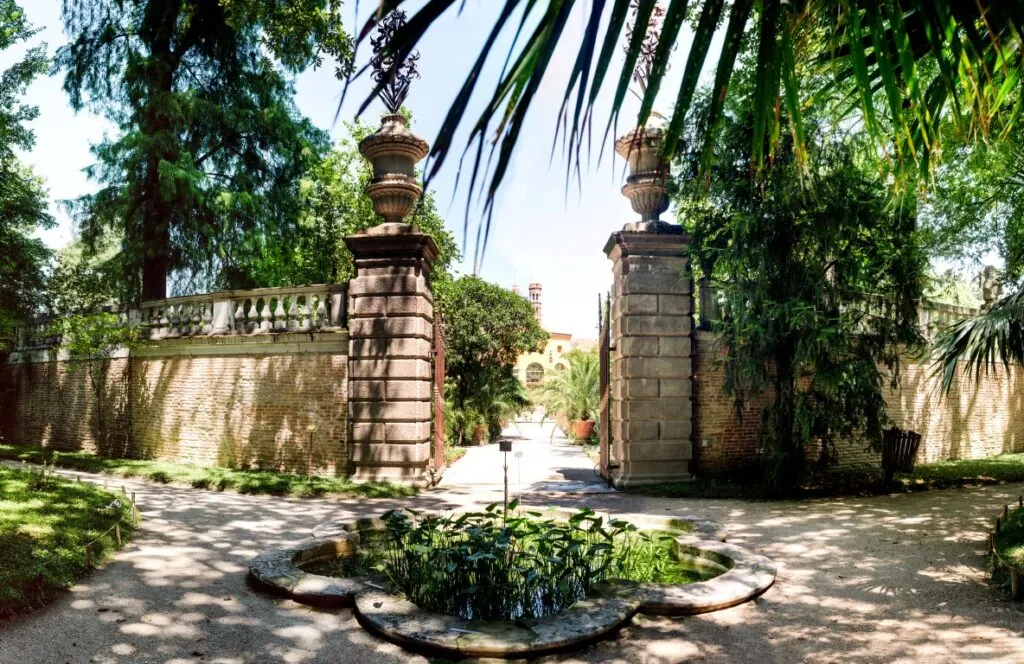
One of the most enchanting things to do in Padova is to visit the gorgeous Botanical Garden, recognized by UNESCO as a World Heritage Site and considered to be the original botanical garden in Europe.
Known in Italy as the Orto Botanico di Padova, it was founded in the mid-16th century and besides being considered the world’s oldest Academic Botanical Garden, it’s known as the birthplace of horticulture and botanical science.
To this day it continues to be a key institution for medicinal and scientific research, and it’s part of the University of Padua.
This glorious attraction, thankfully, is not only used for academic purposes but also welcomes visitors to marvel at its 236,000 square feet (22,000 square meters) of lush greenery.
The garden is divided into different sections according to the plants’ categories, from aquatic to medicinal and exotic varieties. Statues, information plaques, and beautiful pathways are located on the property to ensure an utterly enjoyable visit.
Visit the Basilica di Sant’Antonio di Padova
One of the most important religious sites in Padua, the Basilica of Saint Anthony of Padua is a Catholic pilgrimage site whose history dates back to the 13th century.
It was built when Saint Anthony was canonized to house his remains, and though it was initially a small chapel, it then evolved into the glorious Basilica that you’ll get to visit today, which is one of the eight international shrines recognized by the Holy See.
Its architecture blends Gothic and Romanesque styles, boasting impressive domes and a detailed facade that you’re bound to be staring at for a long time. The basilica’s exterior, which tells the story of St Anthony of Padua through its decorative elements and statues, is already worth your trip to the site.
The interior, however, is nothing short of magnificent featuring several chapels that are beautifully decorated with frescoes and sculptures. The Chapel of the Relics is the most significant one, and the one which attracts the most visitors seeking to pay their respects to Saint Anthony.
Basilica di Sant’Antonio di Padova Opening Hours: Daily from 6.30 AM to 7 PM.
Basilica di Sant’Antonio di Padova Entrance Fee: Free.
Drink an Aperol Spritz
Did you know Aperol was born in Padua?! The popular Aperol Spritz is one of the most widely consumed drinks in all of Italy, especially during the golden-hour aperitivo in which locals gather for nibbles and cocktails before dinner.
And the very birthplace of the beloved Aperol is none other than this precious city in Italy, so you can’t skip on drinking a refreshing spritz when you visit Padua.
While you’ll be able to order an Aperol Spritz pretty much anywhere in the city, these are the places I recommend:
▶️ Corte Sconta is a wine bar located in the city center that has a very cozy, local atmosphere and serves cicchetti with various toppings. Among the drinks you can get at the bar are wine, beer, and of course, Aperol. It’s a great spot to go for a laid-back aperitivo after a day exploring the city.
▶️ All’Ombra della Piazza is a popular eatery where you can go for incredibly tasty pizzas, panini, cicchetti, and polpette, paired with a delicious Aperol Spritz. It’s situated in the heart of Padua
▶️ Enoteca La Botte Piccola is another bustling wine bar that’s a hit during aperitivo time. The place offers an incredible variety of cicchetti, the Venetian version of tapas, accompanied by the authentic Aperol Spritz. Other drinks, including wine and beer, are also available.
➤ Eager to truly delve into the culture of Aperol? Join a Padova: Guided Spritz Walk to learn all the details about Italian Aperitivo, and discover the history of Aperol, which was created there over 100 years ago. You’ll indulge in two different spritz drinks served with local bites. ➥ BOOK IT HERE
Sign Up for a Cooking Class
As most major cities in the country, Padua is no exception for boasting exquisite cuisine that not only features Italian classics but its very own traditional dishes.
Risotto with Rovinassi is one of the most typical meals in Padua, consisting of risotto with chicken livers. Tramezzini, cold Italian sandwiches made with soft, white bread are also incredibly popular in the city, along with rice or pasta cooked in duck broth.
Oca in Onto Padovana is another classic, made with boneless goose meat that is salted and preserved in goose fat.
To take your foodie experience in Padua to the next level, join a cooking class and learn from an expert chef all the techniques and ingredients needed to craft the local cuisine.
➤ Padua: Private Cooking Demo & Meal at a Local’s Home caters to groups of up to 10 people. You’ll visit a local in their home and watch as they whip up four courses of regional dishes, including pasta, meats, a starter, and dessert. In the end, you’ll sit down with your host to savor the dishes along with wine. ➥ BOOK IT HERE
➤ This Small Group Market Tour and Cooking Class in Padua starts with a market visit where you’ll pick fresh ingredients, and continues with a hands-on culinary experience. You’ll prepare fresh pasta and tiramisu from scratch, and indulge in your dishes when they’re ready! ➥ BOOK IT HERE
Learn About the Jewish Heritage of Padua
The city of Padua has a rich Jewish history that’s worth getting to know, and there’s no better place for that than the Jewish Ghetto.
The city was home to Jews since as early as the 13th century, and it was a center point for Jewish studies, with a celebrated Rabbinical Academy that attracted students from all over Europe. Padua Medical School was also the only one to accept Jewish students at the time.
In the early 14th century, however, after the Venetian conquest, the Jewish community started to lose many of its rights, being forced to sell their homes and losing studying privileges, and in 1601 the Jewish Ghetto was established.
The quarter, which is adjacent to Piazza delle Erbe, was already a hub for the community, featuring 2 synagogues and several Jewish shops, so it was the area chosen for the ghetto.
Highly unsanitary and cramped, the ghetto was small and vertical, with several low-ceiling apartments in each building and housing over 600 people.
It wasn’t until 1797, when Napoleon’s regimen of equality was settled, that the ghetto was abolished.
Besides trying Kosher cuisine at the shops, and visiting the synagogues you can’t miss a trip to the Jewish Heritage Museum of Padua to learn more about the history of the quarter and its inhabitants. It offers a very interesting multimedia experience that will help you immerse yourself in the stories.
➤ Ready for an even more comprehensive visit? Padua: Jewish Heritage Museum and Synagogue Tour is a 2-hour trip that includes visits to the synagogue and the museum, accompanied by an expert guide. Hear all about the Jews’s life in the quarter, their history, and traditions. ➥ BOOK IT HERE
Take a Day Trip to Venice
Venice, aka The City of Canals, is one of the most mesmerizing Italian cities. Home to world-renowned canals, magnificent architecture, and picturesque islands, no trip to Northern Italy is complete without a visit to Venice. Padua and Venice are 22 miles (36km) away, which makes the city of canals an easy day trip destination.
Things to do in Venice include enjoying a gondola ride, checking out Rialto Bridge, visiting Piazza San Marco and its striking Basilica, learning about the eerie past of Doge’s Castle and the Bridge of Sighs, visiting the islands of Burano and Murano, and indulging in Cicchetti for Aperitivo time.
The easiest – and fastest – way to travel from Padova to Venice is by train. The journey takes approximately 15 minutes, and there are trains departing frequently throughout the day, with tickets costing as little as 4€. You can buy a return ticket to ensure your return from Venice to Padua.
➤ You can alternatively join this Live Venice as a Local departing from Padua. It’s a full-day excursion that includes roundtrip train tickets and a guided walking tour around the city, checking out all the main sights as you learn all about them. ➥ BOOK IT HERE
Go on a Wine Tour or Wine Tasting in Padua
Did you know the Veneto region has delicious, world-class wine? While Tuscany tends to steal the limelight when it comes to wine, Veneto is one of the country’s main producers, and you can try the region’s best by joining a wine adventure in Padua.
I’ve selected the best experiences available for you to choose from.
➤ From Padua: Walking & Wine Tasting City Tour is a delectable experience in the center of the city. You’ll walk to different eateries as you learn about the culinary scene from your guide, and taste up to 4 different Veneto wines paired with local delicacies. ➥ BOOK IT HERE
➤ 8-Hour Prosecco Wine and Tastings Tour from Venice or Padua takes you to discover the very heart of the Prosecco DOCG area. You’ll visit two wineries for guided Prosecco tastings, wander around the lush vineyards, and cap off the day with lunch at a local trattoria. ➥ BOOK IT HERE
➤ Amarone Wine Tour & Tasting from Venice, Padua, or Verona is the perfect excursion to immerse yourself in the scenic vineyard landscapes of Veneto. You’ll visit the Valpolicella Valley, where Amarone wine is produced, and learn all about its making process before indulging in five tastings paired with cheese. You’ll also savor a traditional lunch at a restaurant. ➥ BOOK IT HERE
➤ From Padua: Olive Oil & Wine in the Euganean Hills takes you to Colli Euganei, renowned for its excellent wine and olive oils. Enjoy a winery visit, learning about the making processes and techniques before tasting the wine. Continue to an olive oil mill to sample the product with local bites, and pass by beautiful highlights of the region as your guide tells you all about them. ➥ BOOK IT HERE
